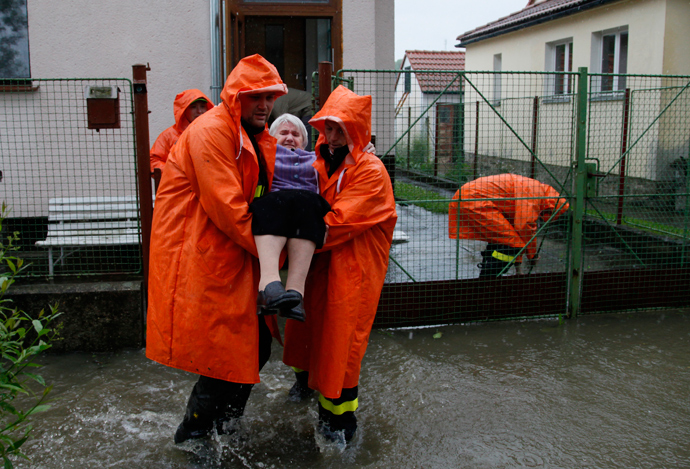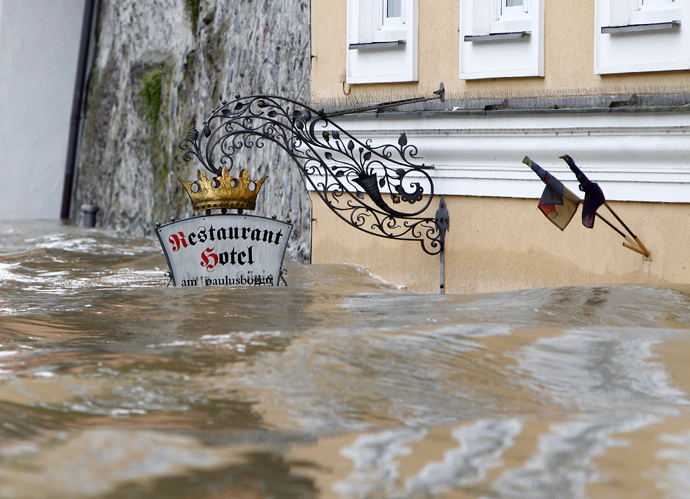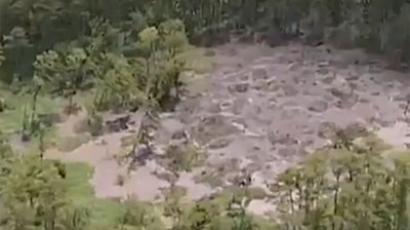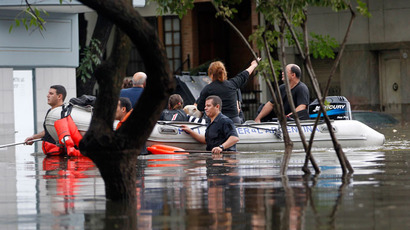Central Europe on high alert amid worst-in-decade flooding (PHOTOS)
Floods raging across central Europe have killed nine people and left several missing, while 7,000 residents have been evacuated in the Czech Republic. No respite is in sight, with more heavy rains expected later this week.
Six people died in the Czech Republic from what appears to be the
worst flooding in a decade, and Prague declared a state of emergency after the Vltava River reached
its highest flood alert level. Eight metro stations have been
shut down, and the Prague Zoo has ordered the evacuation of
animals whose cages could be submerged. Prague’s Charles Bridge,
built in the 14th Century, was also closed.
Volunteers built sandbag walls in the Czech capital to hold back
the banks of the swollen river from overwhelming the historic
city center, a UN World Heritage Site.

The Vltava River is currently flowing through Prague at a volume
of 3,000 cubic meters of water per second, while the norm is only
149 cubic meters per second. The river’s safety barriers can hold
back a maximum of 3,250 cubic meters per second.
According to CTK news agency, flooding in the Czech capital may
peak on Tuesday. "The story is not yet over here," Environment
Minister Tomas Chalupa said.
On Monday, Prague's sewage treatment plant was closed to prevent
damage from the high water, meaning the capital’s sewage is
currently being dumped directly into the river. The plant will
likely reopen on Tuesday or Wednesday.
Central Europe last saw similar floods in 2002, when 17 people
died in the Czech Republic, causing an estimated $26 billion in
damage, Reuters reported.

The flooding, which comes after several days of torrential
rainfall, has also affected parts of Germany, Slovakia, Hungary
and Poland. In Austria, two have died and another two have gone
missing. In some areas, two months’ worth of rain fell in just a
couple days.
Swollen rivers gushed into the old section of Passau in southeast
Germany as waters rose to levels not seen in over five centuries,
according to German news agency DPA, which reported that the
water levels were the highest recorded in Passau since 1501.
''The situation is extremely dramatic,'' Herbert
Zillinger, a spokesperson for Passau's crisis center told AP.
Electricity has been shut down as a precaution as rescue teams
are use boats to evacuate residents from flooded parts of the
city. Authorities evacuated a prison in danger of flooding,
moving 60 inmates to two other nearby facilities.
The German army has deployed 1,760 soldiers in the south and east
of the country to help local authorities reinforce flood
defenses. Volkswagen shut down a plant in Zwickau, in the eastern
German state of Saxony, after flooding made it impossible for
workers to reach the factory.

Some of the worst flooding was seen around the Danube River,
Europe's second-longest after Russia’s Volga River. The Danube
originates in the German town of Donaueschingen, and passes
through four European countries – Austria, Slovakia and Hungary –
before it empties into the Black Sea. German Chancellor Angela
Merkel will visit flood-hit areas on Tuesday.
In the Austrian city of Salzburg, some 160 train passengers were
put up overnight in army barracks after being stranded by heavy
floods.
Meteorologists fear the flooding could follow the course of the
Danube River down to other European countries along its route.
Flood barriers have also been erected along the banks of the
Danube River where it passes through Bratislava, the capital of
Slovakia. "We are getting bad news from Germany and Austria.
We have to do all we can to protect... the capital," Slovak
Prime Minister Robert Fico said.
Gyorgy Bakondi, the head of the Hungarian National Disaster
Authority, told local media that water levels in the Danube River
could exceed 2002’s worst-ever record, and that 400 people are
currently working on flood defenses.















